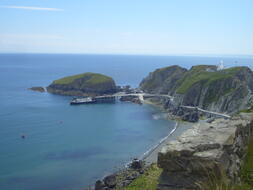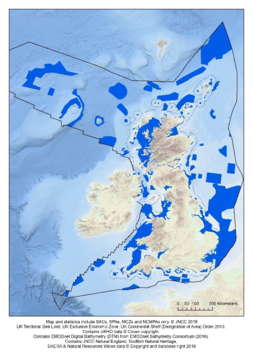What is an MPA?
- Home
- Environment & Research
- Marine Protected Areas (General)
- What is an MPA?
Page review/updated 04/12/2024
(Content of page last updated: 27th June 2023)
A protected area is defined by the International Union for Conservation of Nature as ‘a clearly defined geographical space, recognised, dedicated and managed, through legal or other effective means, to achieve the long term conservation with associated ecosystem services and cultural values.’ Marine Protected Areas protect areas of the marine, coastal and estuarine environment.
The UK Government has a vision of clean, healthy, safe, productive and biologically diverse oceans and seas, and Marine Protected Areas help deliver this vision by providing healthy, functioning and resilient marine ecosystems. The UK signed up to international agreements that aimed to establish an ecologically coherent network of MPAs by 2012. The UK Administrations follow several key principles in their development of an ecologically-coherent and well-managed MPA network. These principles were derived from:-
Features: the network should represent the range of habitats and species for which MPAs are considered appropriate
Representivity: the network should include areas that best represent the range of habitats and species
Connectivity: the network should comprise MPAs that are well-distributed and take into account linkages between marine systems
Resilience: the network should include more than one example of a feature in individual MPAs and ensure they are of sufficient size to deliver conservation benefits
Management: the network should ensure the protection of marine habitats and species for which an MPA has been identified

The type of Marine Protected Area MPA depends on the legislative measure in place to provide protection to the marine species and habitats that occur in them.
Sites may be protected as part of European or National legislation.
Lundy, situated in the Bristol Channel was Britain’s first MPA.
A voluntary marine nature reserve was established around the island in 1971.
TYPES OF MPAS
The main types of MPAs in English waters are:

- European Marine Sites
MPAs designated as part of the European Natura 2000 network are referred to collectively as European Marine Sites (EMS). EMS are composed of Special Areas of Conservation (SACs) and Special Protection Areas (SPAs), which extend below mean high water. These are some of our most important marine and coastal habitats and species of European importance. An EMS can be either a SAC or a SPA, or a combination of both.
SACs are designated under the EC Habitats Directive and are designed to protect habitat type or species listed in the Annexes of the Directive. They contain animals, plants and habitats that are considered special or threatened in Europe. The EC Habitats Directive is transposed into UK law through the Conservation of Habitats & Species Regulations 2017 (Habitat Regs.).
SPAs are designated under the EC Birds Directive, to protect internationally and nationally important, rare, vulnerable, or regularly occurring migratory birds and their supporting habitats. The EC Birds Directive is also transposed to UK law through the Habitat Regs.
2. Marine Conservation Zones
Marine Conservation Zones (MCZ) are designated under the Marine and Coastal Access Act 2009 (MaCAA). MCZs protect a range of nationally important marine wildlife, habitats, geology and geomorphology in English inshore waters and offshore water off England, Wales and Norther Ireland. They are important in conserving diversity of rare or threatened habitats and species. They are designated to form part of an ecologically coherent network of MPAs alongside EMS, Sites of Special Scientific Interest (SSSIs) and Ramsar sites.
3. Ramsar Sites
Ramsar sites are Wetlands of International Importance under the Convention on Wetlands of Internal Importance Especially as Waterfowl Habitat (the Ramsar Convention) 1971 and came into force in 1975. The Convention adopts a broad definition of wetland, namely “areas of marsh, fen, peatland or water, whether natural or artificial, permanent or temporary, with water that is static or flowing, fresh, brackish or salt, including areas of marine water the depth of which at low tide does not exceed six metres”. Wetlands “may incorporate riparian and coastal zones adjacent to the wetlands, and islands or bodies of marine water deeper than six metres at low tide lying within the wetlands”. As such, Ramsar sites that protect intertidal or subtidal habitats and species are considered MPAs.
4. Sites of Special Scientific Interest
Sites of Special Scientific Interest (SSSIs) are designated in England, Scotland and Wales to protect species, habitats and geological features of national importance. They are notified and managed under the Wildlife and Countryside Act 1981 (as amended). They are MPAs where they protect intertidal and subtidal habitats and species although they normally do not protect marine wildlife below the low water mark.
5. Marine Nature Reserves
Marine Nature Reserves were designated under the same legislation as SSSIs. However, MNRs are limited in scope and the Marine and Coastal Access Act 2009 introduced the mechanism for them to become Marine Conservation Zones, such as for Lundy which became the UK’s first MCZ in 2013.
